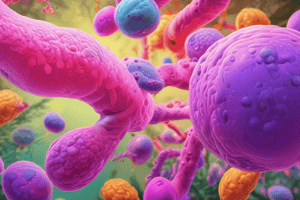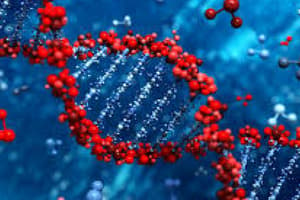Podcast
Questions and Answers
What is the most common complication of a pancreatic pseudocyst?
What is the most common complication of a pancreatic pseudocyst?
- Spontaneous rupture (correct)
- Development of cancer
- Infection of the cyst
- Formation of new cysts
Which pancreatic condition is characterized by the breakdown of tissue forming a sterile abscess?
Which pancreatic condition is characterized by the breakdown of tissue forming a sterile abscess?
- Hemorrhagic pancreatitis
- Phlegmonous pancreatitis
- Pancreatic pseudocyst (correct)
- Chronic pancreatitis
What risk factor is NOT associated with adenocarcinoma of the pancreas?
What risk factor is NOT associated with adenocarcinoma of the pancreas?
- High fat diet
- Increased alcohol consumption (correct)
- Smoking
- Chronic pancreatitis
Which of the following is NOT a characteristic of endocrine pancreatic neoplasms?
Which of the following is NOT a characteristic of endocrine pancreatic neoplasms?
The Whipple procedure involves the removal of which structures?
The Whipple procedure involves the removal of which structures?
Which condition is characterized by the presence of necrotic pancreatic tissue and associated liquid collections?
Which condition is characterized by the presence of necrotic pancreatic tissue and associated liquid collections?
What is the primary characteristic of hemorrhagic pancreatitis?
What is the primary characteristic of hemorrhagic pancreatitis?
Chronic pancreatitis is most often associated with which of the following factors?
Chronic pancreatitis is most often associated with which of the following factors?
What is a common complication developed from chronic pancreatitis?
What is a common complication developed from chronic pancreatitis?
What distinguishes a pancreatic pseudocyst from a pancreatic abscess?
What distinguishes a pancreatic pseudocyst from a pancreatic abscess?
What characterizes hemorrhagic pancreatitis?
What characterizes hemorrhagic pancreatitis?
Which statement best describes phlegmonous pancreatitis?
Which statement best describes phlegmonous pancreatitis?
What is one of the significant features of chronic pancreatitis?
What is one of the significant features of chronic pancreatitis?
How does a pancreatic abscess typically present sonographically?
How does a pancreatic abscess typically present sonographically?
Which of the following is NOT a typical cause of chronic pancreatitis?
Which of the following is NOT a typical cause of chronic pancreatitis?
Chronic pancreatitis is associated with all of the following changes EXCEPT:
Chronic pancreatitis is associated with all of the following changes EXCEPT:
What is the primary concern with phlegmonous pancreatitis?
What is the primary concern with phlegmonous pancreatitis?
Which of the following describe pancreatic neoplasms?
Which of the following describe pancreatic neoplasms?
Study Notes
Pancreatic Pseudocysts
- Acquired condition where pancreatic enzymes leak and break down tissue, forming a sterile abscess in the abdomen.
- Walls are not true cyst walls, giving rise to the name "pseudocyst."
- Not always spherical as they take the shape of the surrounding space.
- May contain internal echoes and loculations.
- Most common complication is spontaneous rupture (5% of cases).
- Half of ruptures drain into the peritoneal cavity, causing sudden shock and peritonitis.
- 50% mortality rate.
Cystic Lesions of the Pancreas (Congenital)
- Autosomal Dominant Polycystic Kidney Disease
- Von Hippel-Lindau Disease
- Cystic Fibrosis
- True Pancreatic Cysts
Exocrine Pancreatic Lesions
- Solid: Adenocarcinoma
- Cystic: Cystadenoma, Cystadenocarcinoma
Adenocarcinoma
- Most common primary neoplasm of the pancreas.
- Accounts for over 90% of malignant pancreatic tumors.
- 60-70% occur in the head of the pancreas.
- Appear hypoechoic with irregular borders sonographically.
- Metastasizes to liver, lung, lymph nodes, and bone.
- Can cause obstructive jaundice.
Risk Factors for Adenocarcinoma
- Smoking
- High-fat diet
- Diabetes
- Chronic pancreatitis
The Whipple Procedure
- Surgical procedure that removes the C-loop of the duodenum, head of the pancreas, gallbladder, and common bile duct (CBD).
- Seldom has a good outcome, but complete cure is possible.
Endocrine Pancreatic Neoplasms
- Arise from islet cells.
- Slow growth rate.
- Most are malignant.
- Difficult to detect due to small size and location in the tail and body of the pancreas.
- Appear hypoechoic and solitary.
- Types include:
- Insulinoma (60%)
- Gastrinoma (18%)
Metastatic Disease to the Pancreas
- Rare
Pancreatic Transplants
- Usually performed for diabetes.
- Sometimes done in conjunction with renal transplants.
- Located in the right lower quadrant (RLQ) of the abdomen.
- Rejection manifests as higher resistance flow and heterogeneous echo patterns.
Lab Values
- Serum Amylase: Elevated levels (2x normal) indicative of acute pancreatitis, but can be affected by other diseases.
- Urine Amylase: May be elevated in pancreatitis.
- Lipase: Evaluates damage to the pancreas.
- Glucose: Useful for detecting glucose metabolism disorders.
Scanning Techniques
- Challenging due to surrounding stomach and bowel.
- Appears iso- or hyperechoic compared to the liver.
- Use 5 MHz transducer.
- Begin in the transverse plane, rotated slightly counterclockwise.
- Identify the splenic vein.
- Be cautious with the long axis view, differentiating between patient position and organ orientation.
Anatomical Landmarks
- Superior Mesenteric Vein (SMV)
- Gastroduodenal Artery (GDA)
- Superior Mesenteric Artery (SMA)
- Splenic Vein (SV)
- Inferior Vena Cava (IVC)
Sagittal Views
- Pancreas (PANC)
- Gastroduodenal Artery (GDA)
- Hepatic Artery (HEPATIC A)
- Portal Vein (PV)
- Inferior Vena Cava (IVC)
- Gallbladder (GB)
Pancreatic Duct
- Identify pancreatic tissue on both sides of the duct.
- Use color Doppler to ensure it is not a blood vessel.
- Appears transversely.
- Normal size is 2mm or less.
Pancreatitis
- Pancreas is digested by its own enzymes.
- Most common cause is biliary tract obstruction.
- Alcohol abuse is the second most common cause.
- Sonographically, acute pancreatitis presents as a hypoechoic, enlarged pancreas.
Hemorrhagic Pancreatitis
- Rapid progression of acute pancreatitis with rupture of pancreatic vessels and subsequent hemorrhage.
Phlegmonous Pancreatitis
- An inflammatory process that spreads along fascial pathways causing localized areas of diffuse inflammatory edema that may progress to necrosis.
Pancreatic Abscess
- Serious complication.
- Secondary to pancreatitis, post-operative procedures, or neighboring infections.
- Appears sonographically as a poorly defined hypoechoic mass.
Chronic Pancreatitis
- Recurrent attacks of acute pancreatitis.
- Causes continuous destruction of pancreatic parenchyma.
- Characterized by fibrous scarring, loss of acinar cells, and a plugged pancreatic duct.
- Sonographically:
- Increased echogenicity.
- Decreased size.
- Calcifications
The Pancreas
- Divided into four sections:
- Head (includes the uncinate process)
- Neck
- Body
- Tail
Normal Location
- Anterior to the inferior vena cava (IVC) and aorta.
- Retroperitoneal.
- Posterior to the gastroduodenal artery.
- Inferior to the liver.
- Posterior to the stomach.
- Anterior to the splenic vein.
- Celiac trunk typically marks the superior border.
- Tail is surrounded by the left kidney (Lk), spleen, stomach, and splenic flexure.
- Tail is inferomedial to the spleen.
The Pancreas
- Lies in a transverse plane.
- Rotated, with the head slightly inferior to the tail.
- Size:
- Length (head to tail) - approximately 15 cm.
- Head is the thickest part, measuring 2-3 cm anteroposteriorly (AP).
- Normal pancreatic duct size: 2mm or less
Pancreatic Ducts
- Two ducts:
- Duct of Wirsung: Primary duct that extends the length of the pancreas.
- Duct of Santorini: Secondary duct that drains the upper anterior head.
- Pancreatic divisum - occurs when these ducts fail to fuse.
The Pancreas - Exocrine & Endocrine Functions
- Exocrine function:
- Acini cells release digestive enzymes:
- Lipase: digests fats
- Amylase: digests carbohydrates
- Pancreatic juice contains a high concentration of sodium bicarbonate to neutralize gastric acid.
- Acini cells release digestive enzymes:
- Endocrine function:
- Islets of Langerhans produce hormones that are released into the bloodstream.
- Cell types:
- Alpha: produce glucagon (increases blood glucose levels)
- Beta: produce insulin (lowers blood glucose levels)
- Delta: produce somatostatin (inhibits insulin and glucagon release)
Studying That Suits You
Use AI to generate personalized quizzes and flashcards to suit your learning preferences.
Related Documents
Description
This quiz covers the various pancreatic lesions, focusing on pancreatic pseudocysts, congenital cystic lesions, and exocrine pancreatic lesions. Test your understanding of the characteristics, complications, and classifications of these conditions, including adenocarcinoma. Gain insights into the implications of these pancreatic abnormalities.




